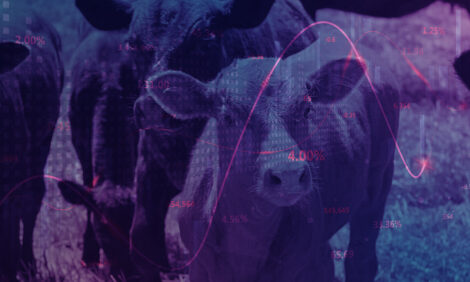



Weekly global protein digest: Cattle, beef prices posted significant gains through 1st half of 2025
Livestock analyst Jim Wyckoff reports on global protein newsUSDA closes southern border after new screwworm case detected in Mexico
USDA Secretary Brooke Rollins late Wednesday ordered an immediate shutdown of livestock trade through all southern border ports following the detection of a new case of New World Screwworm (NWS) in Veracruz, Mexico. The case was confirmed by Mexican authorities in Ixhuatlan de Madero — just 370 miles from the US border, raising serious concerns about the effectiveness of Mexico’s containment efforts and forcing USDA to abandon a phased port reopening plan that was scheduled to run from July 7 through mid-September. USDA is maintaining strict animal movement controls, ramping up surveillance and trapping, and advancing plans to expand sterile fly dispersal capabilities in South Texas. USDA will continue to monitor conditions on the ground in Mexico and only consider reopening trade when it is confident the screwworm threat is contained.
Trump administration sues California over egg laws
The Trump administration filed suit against California in federal court, challenging the state’s laws mandating larger cage space for egg-laying hens and stricter egg standards. The Department of Justice (DOJ) argues California’s requirements — including Proposition 12 and AB 1437 — illegally encroach on federal authority under the Egg Products Inspection Act and are fueling a historic rise in egg prices by imposing “unnecessary red tape.” DOJ’s lawsuit, filed Wednesday in the Central District of California, seeks to block both laws, claiming California’s regulations “effectively prevented farmers across the country from using a number of agricultural production methods which were in widespread use — and which helped keep eggs affordable.” The administration further contends that California’s rules amount to an unlawful attempt to regulate the quality, inspection, packaging and labeling of eggs, which DOJ says is the federal government’s sole prerogative.
Gene-edited bacon arrives without labels: Is consumer trust at risk?
Lack of transparency around CRISPR pork sparks debate over labeling, choice, and food system trust
In his recent column, Dr. Sylvain Charlebois warns that gene-edited meat is coming to Canada — without the transparency or labeling consumers might expect. The says the arrival of CRISPR-edited pork, approved by the US FDA and entering the North American market as soon as next year, poses a fundamental challenge: “Whether or not gene-edited meat poses a food safety risk isn’t the central issue. The issue is whether consumers have the right to know how their food was produced.”
Charlebois, Director of the Agri-Food Analytics Lab at Dalhousie University, writes that gene editing is already a fact of life in US pork production and, due to Canada’s imports, will soon be a reality for Canadian consumers as well — “no label will tell you whether your pork chop or bacon came from a genetically altered animal.”
He notes that industry leaders like Quebec-based duBreton are raising the alarm, arguing that gene editing is “incompatible with organic and humane production standards — and more importantly, with informed consumer choice.”
Drawing parallels to Canada’s earlier experience with genetically modified salmon, Charlebois warns, “even if a technology is deemed safe, consumer perception can dictate its commercial fate.” The earlier rollout of GM salmon — without mandatory labeling — sparked backlash and saw major retailers reject the product, ultimately forcing the company out of Canada.
“Labeling gene-edited products is not about fear — it’s about trust,” Charlebois writes. He stresses that the debate isn’t over the safety or potential of gene editing in food, but about the right to know and to make informed decisions. “Consumers don’t need to be protected from innovation, but they do need to be respected. The question is not whether gene-edited meat should exist; it’s whether its presence should be hidden.”
Ultimately, Charlebois calls for openness and transparency from the food industry: “If gene editing truly delivers benefits to farmers, processors, and consumers, then let’s have that conversation openly — with proper labeling, sound science, and the transparency Canadians expect from a modern food system.”
US ends bird flu emergency as infections subside
CDC winds down response amid ongoing low-level risk
The US Centers for Disease Control and Prevention (CDC) has officially ended its emergency response to the bird flu outbreak after a marked decline in human and animal infections. The move, which took effect last week, comes as states hardest hit by the virus — including California and Washington — also scale back their efforts.
Going forward, the CDC will report bird flu data as part of its regular seasonal influenza updates and shift to monthly postings on people monitored and tested for H5N1. Animal infection data will no longer be featured on the agency’s website.
While experts acknowledge that the emergency phase has passed, some warn that reduced surveillance could hamper efforts to spot new risks. “We are letting our guard down,” cautioned Michael Kinch, infectious disease expert at Stony Brook University.
The CDC’s decision reflects declining case numbers — most of which were among agricultural workers in contact with sick poultry or dairy herds. California, which saw 38 human infections in 2024, and Washington, with 11, have already ended their state-level emergencies. However, some health officials, like Dean Blumberg of UC Davis, warn that relaxing monitoring could mean, “you’ll be one step behind,” if cases surge again.
Of note: Although one death was reported in January, the CDC maintains that the risk to the general public remains low.
China weighs lifting ban on Brazilian chicken imports
BRICS Summit highlights push to reopen key poultry market
China is considering lifting its countrywide ban on Brazilian chicken meat imports, imposed in mid-May after a bird flu outbreak in southern Brazil. The topic was a focal point during bilateral talks at the BRICS summit in Rio de Janeiro, with Chinese Premier Li Qiang signaling that China is “swiftly studying the protocols” required to resume purchases. While most countries have already eased restrictions after the outbreak was declared resolved, China remains one of nine nations still enforcing bans, with Brazilian poultry exports suffering a 23% drop in June. No timeline has been set for China’s decision, which remains critical for Brazil’s poultry sector and global trade flows.
US poultry farmers sue major processors for alleged “no poach” conspiracy
Class action accuses Foster Farms, Mountaire, George’s, and others of suppressing grower pay
A coalition of poultry farmers filed a proposed class action lawsuit in federal court on Tuesday, accusing several of the nation’s leading chicken processors — including Foster Farms, Mountaire, George’s, and House of Raeford — of conspiring to restrict competition for chicken growers and artificially suppressing their pay. The suit, filed in the US District Court for the Eastern District of Oklahoma, claims these processors illegally agreed not to recruit or hire each other’s contract growers, thereby violating federal antitrust laws.
The complaint alleges that the companies worked together to enforce a “no poach” agreement, limiting growers’ ability to move between processors and shielding the companies from normal market pressures that would raise grower compensation. “The cartel members attempted to insulate themselves from normal competitive pressures,” the lawsuit states.
This new case, brought by law firms Hausfeld and Berger Montague on behalf of thousands of growers, builds on previous antitrust litigation against the poultry industry. Last year, Pilgrim’s Pride and Tyson Foods paid $100 million and $21 million respectively to settle similar claims, while denying any wrongdoing.
Plaintiffs in the new lawsuit seek unspecified monetary damages and a court order to block further anticompetitive conduct. The case is Haff Poultry et al v. Mountaire Farms Inc et al, No. 6:20-md-02977-RJS-CMR. Foster Farms, Mountaire, George’s, and House of Raeford did not immediately comment on the allegations.
Cattle and beef prices have posted significant gains through the first half of 2025
The price gains are driven by historically tight cattle supplies, persistent demand, and ongoing uncertainty around trade policy and animal health. James Mitchell of the University of Arkansas writes that “Oklahoma City steer prices for 500-600 lb calves have averaged $347/cwt year-to-date, up 21% from the same period in 2024 and more than double the 2019-2023 average.” Feeder cattle prices (700-800 lb) are also strong at $281/cwt, and fed cattle prices in the five-area region are averaging $215/cwt, a 16% increase from last year. The Choice boxed beef cutout has averaged $342/cwt — 13% higher than 2024 and 31% above the five-year average.
“Cattle inventories remain the fundamental driver,” Mitchell notes, pointing to the January 1 report showing total US cattle inventories at 86.7 million head — the smallest since 1951. With beef cow numbers down to 27.9 million and the calf crop also shrinking, “supply constraints are supporting prices across market segments.”
Markets have also had to contend with policy risk and animal health events. “There were disruptions to cattle imports from Mexico last fall and again in May following detections of New World screwworm,” Mitchell explains, resulting in new trade restrictions and surveillance. Despite a phased border reopening, “feeder cattle trade flows are still subject to further changes.” (Note: USDA late Wednesday ordered an immediate shutdown of livestock trade through all southern border ports following the detection of a new case of New World Screwworm (NWS) in Veracruz, Mexico.) He adds that “the lack of clarity around future trade policy has made it difficult for market participants to plan around future trade expectations.”
Weekly USDA dairy report
CME GROUP CASH MARKETS (7/3) BUTTER: Grade AA closed at $2.6050. The weekly average for Grade AA is $2.5969 (+0.0609). CHEESE: Barrels closed at $1.7200 and 40# blocks at $1.6850. The weekly average for barrels is $1.7150 (+0.0745) and blocks $1.7006 (+0.0836). NONFAT DRY MILK: Grade A closed at $1.2600. The weekly average for Grade A is $1.2594 (+0.0074). DRY WHEY: Extra grade dry whey closed at $0.6075. The weekly average for dry whey is $0.6006 (+0.0261).
BUTTER HIGHLIGHTS: Domestic butter demand is steady in the East and West regions. Domestic butter demand is lighter in the Central region. Demand from international buyers is strong. Although cream volumes are tightening in some parts of the country, butter manufacturers throughout the country indicate receiving ample amounts of cream for butter manufacturing needs. Butter production schedules vary from steady to lighter for the holiday week. Bulk butter overages range from 7 cents below to 5 cents above market across all regions.
CHEESE HIGHLIGHTS: Block and barrel prices are trending upward in the CME this week. Contractual Class III milk load commitments to cheese manufacturers are being met. Cheese production schedules are mostly steady. Seller's report domestic as steady or lighter with shorter holiday week at hand. Export demand is stronger. High summer temperatures in the Central region are contributing to lighter milk output, and some cheesemakers say they are turning to the spot market to secure sufficient volumes to run full production schedules. Class III milk prices range from $8 to $1-under, as of reporting. Cheese production is steady to lighter in the Central region. Milk handlers indicate Class III milk demand from cheese manufacturers is strong. However, increasing temperatures in the West region are generally decreasing farm level milk output, which is tightening spot milk availability in much of the region. Cheese production schedules are steady for the most part. Some manufacturers report that spot milk availability is not plentiful enough to run full capacity production schedules.
FLUID MILK HIGHLIGHTS: Milk production is lighter for much of the nation. Many stakeholders indicate higher temperatures are playing a part in decreasing milk output. Some lighter manufacturing schedules this holiday week are lessening the impact of declining milk production. Some handlers note 2025 milk production is up on a year over-year basis heading into July. Some manufacturers are purchasing additional spot volumes to fill gaps. Class I demand is seasonally lighter. Class II, III, and IV demands are mixed for the holiday week. Demand for condensed skim milk is steady. Condensed skim milk loads are somewhat more available. Cream multiples for all Classes range 1.15 1.32 in the East, 1.08-1.23 in the Midwest, and 1.04-1.20 in the West.
DRY PRODUCTS HIGHLIGHTS: Low/medium heat nonfat dry milk (NDM) prices moved lower in the West and at the top of the range and mostly price series in the Central and East regions. Contacts report lighter interest from domestic and international purchasers. High heat NDM prices increased at the bottom of the range in the Central and East regions but moved lower at the bottom of the range in the West. High heat NDM production remains light, and inventories are tight in the Central and East regions. Dry buttermilk prices are unchanged in the Central and East regions, but the range moved slightly lower in the West. Demand for dry buttermilk softened ahead of July 4th in the Central and East, but contacts in the West relayed steady demand. Dry whole milk prices are down slightly. In all regions the dry whey price ranges moved higher this week. Contacts in the Central and East regions say domestic demand for dry whey is strengthening. Dry whey inventories are tight but are more available in the West than in the Midwest. Prices for whey protein concentrate 34% moved lower at the bottom of the range this week, amid increasing production. The lactose price range moved higher. Contacts say domestic demand is solid, but spot inventories are tight. Acid and rennet casein prices moved lower this week.
INTERNATIONAL DAIRY MARKET NEWS
WEST EUROPE: On June 29, 2025, France's Ministry of Agriculture and Food Sovereignty confirmed the identification of lumpy skin disease in a herd located in the Savoie area of France. Milk production in Europe is up 1.2% YoY in April, driven by a surge of collections in Ireland, France, Romania, and Poland. Production in Germany is still down.
EAST EUROPE: Foot and mouth disease recently impacted both Hungary and Slovakia, marking the first outbreaks in those countries in over 50 years.
AUSTRALIA: Milk production data from Australia for May 2025 were recently released by Dairy Australia. These data show total May 2025 milk production was 620.3 million liters, down 24.8 million liters (3.8 percent) year over year. Dairy Australia recently released export data for Australia showing milk export volumes from July 2024 - April 2025 were 136,089 metric tons, down 11.3 percent from the same time period a year earlier.
NEW ZEALAND: Milk production data from New Zealand for May 2025 were recently released. These data show total May 2025 production was 993,000 metric tons, up 8.3 percent compared to a year earlier. Export data for May 2025 were recently released for New Zealand. These data showed the value of milk powder, butter, and cheese exports in May 2025 was $2.2 billion, an 18 percent increase compared to May 2024.
SOUTH AMERICA: South American milk production is stronger. Demand for skim and whole milk powder varies from steady to strong in the region. Stakeholders convey price offers for later Q3 whole milk powder are showing downward price movement.



